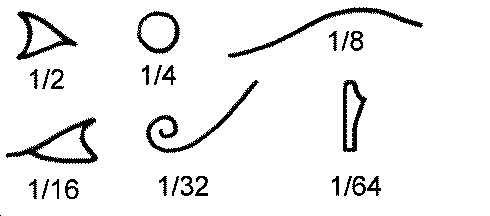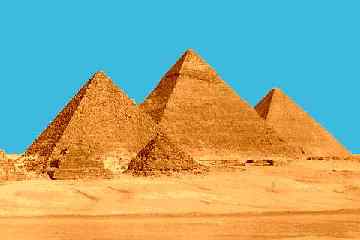
WELCOME TO THE ANCIENT OF EYGPT !!!

Contents

Introduction

Ancient Egyptian history covers a continuous period of over three thousand years. To put this in perspective - most modern countries count their histories in hundreds of years. Only modern China can come anywhere near this in terms of historical continuity. Egyptian culture declined and disappeared nearly two thousand years ago. The last vestiges of the living culture ceased to exist in AD 391 when the Byzantine Emperor Theodosius I closed all pagan temples throughout the Roman Empire. It was not until Napoleon's invasion of Egypt in 1798 that the wonderful artefacts of the Egyptians were seen in Europe and their ancient culture began to awaken from its long slumber.
Travel Back In Time. . . .

It all began more then 5,000 years ago when a great civilization came to power along the bamks of Nile River. The people called this land Kemet which means black, because the soil was so dark. We know it as Egypt. The ancient Egyptians were talented famers, architects, craftmen, and musicians who loved nature and sporta. They were among the first groups of people to create an organized religion. Because the ancitnt Egyptians lived so long ago, you might thinkther lives would become a mistery.but the Egyptians left many clues in the from of paintings, sculptures, tombs, and mummified bodies. And to make sure furture generations had no trouble interpreting the clues, the ancient Egyptians wrote about their lives in a language all their own.
The Game People Played

The ancient Egyptians know how to have a good time. They loved games - especially a boad game called Senet Storytelling was also a really popular way to pass the time. Some of the ancient Egyptians stories have lived on to today. Cinderella is based on a popluar ancient Egyptians tale. Ancient Egyptians boys spent a great deal of time playing sports - especially wrestling and gymnastics. The girls sing, dance, and played with dolls. And just in case you thought the ancient Egyptians were very different then we are, consider this: The spent a lot of time watching professional wrestlers who were hired purely for entertainment.
What Was In Style?

Egypt is a hot country. The ancient Egyptians had to wear light clothing in order to keep cool. Unlike today, ancient Egyptians fashions did't change with seasons. The same styles stayed fashionable fore centeries. The man wore loincoths woven from cotton or liner. Wealthier man also wore a shirt or coat. The woman wore tight, straight, sleeveless dresses that reached down to their ancles. Both men and women wore sandles made from reeds or leather. Ancient Egyptians wore a lote of make up -- both women and men darkened their eyebrows, and wore green paint around their eyes. The women often painted their lips with res ochre and used henna to dye their fingernails yellow and orange. Ancient Egyptians shaved their heads and wre wigs made of sheep's wool or human hair. The wigs weren't just to prevent bad hair day - they served a more practical purpose by protecting the people from harsh sunlight
Meet The Ancient Egyptians

Most ancient Egyptians were famous. Each summer there was a big flood along the valley of the Nile. This made for a pretty dreary summer, but by the the rains end in october, the ground was covered by a thick layer of rich, black silt. The farmers grew crops such as beans, cabbages, cucumbers, barley, flax, and weat. The barley was used to make bread, and flax was woven to make clothing. Not all Egyptians were famers. some were craftmen and artists. After all, every village needed a coppersmith, a potter, a jeweler ( for the wealthy ), ang a weaver. Mining was also popular profession among ancient Egyptians, since the land was rich with copper, goad, amethyst, and turquoise.
Religious Life

The ancient Egyptians believed in families of goads who ruled over the world. The sun god, Amen-Ra, was the most important god of all. But thereb were also gods who looked after the family, the village, and the gavernment. The Egyptians had a strong belief in life after death. They belived that the afterlife would be like Egypt at its most wonderful, so filled their tombs with things the dead person would need throughout eternity, such as clothing, games, food, and jewelry.
The Pharaohs

The ancient Egyptians obeyed their king, the Pharaoh, not just because he was the political leader of the lsnd. The ancient Egyptians worshipped the Pharaoh because they belived he was the son of Amen-Ra. There were a great number of pharaohs who ruled over ancient Egyptians. In fact there were so many that most that most are only remembered by name - the lays they created the monuments they built disappeared centuries ago. The last Pharaoh ruled until 30 B.C That's when Augustus Caesar took over, Egypt became a province of ancient Rome.
Writings On The Wall

For centuries after the fall of ancient Egypt, people believed that the drawings on the walls tombs were simply stories told in pictures. Then in 1799, a small stone was found near the Egyptian town of Rosetta. The Rosetta Stone was unique, becasue the same message had been carved on it in several languages. One of the languages carved on the stone was ancient Greek. Another was ancien Egyption hieroglyphics. Two scholars, Thomas Young and John Francois Champollion, compared the hieroglyphs with the ancient Greek writings, and discovered that each "picture sign" stood for a sound. It took John Champollion another 20 years to completely "crack the code" of hieroglyphics.
Misterious Mummies
Ancient Egyptians believed that after a person died, his body would meet with his soul in the afterlife. So they wanted to be sure that the dead body was in the best possible condition. To do that, they removed all of the internal organs except the heart, embalmed the body with resin or another preservative, wrapped the body tightly in strips of cloth, and placed the body in a tightly sealed coffin. Thanks to this process, and to the dry air of the Egyptian desert, many Egyptian mummies have been preserved for more than 5,000 years.
The Power Of The Pyramids

There is an old Arab proveb that says "Man fears time, and man fears the pyramids". The giant pyramids, of there are more than 90, have fascinated people since the time when Pharaohs still ruled over Egypt. In fact, there is proof that more than 3000 years ago the tourists were already visiting these remartkable structures. One, "Ahmose, Sone of Iptah," signed his name on the Step Pyramid of Saqqara, and wrote that the pyramid looked "as though heaven were in it." Scientists have dated Ahmose's "graffiti" back to the year 1600 B.C! By then the Step Pyramid was already 1000 years old. The pyramids were built as tombs for the Pharaohs. But over the centuries, grave robbers have emptied them. We will probably never know what treasures these magnificent structures once held.
The Riddle of The Sphinx
Imagine a creature with theb body of a lion and the of a man. Thet is the Sphinx. The magnificent statue, carved 4,500 years ago, stands guard over the Great Pyramid. There are some who say thatSphinx's face is actually the face of King Khafre, the Pharaoh who ordered the statue built. Can you answer the ancient riddle of the Sphinx? I say! I say! What has one voice and four feet, then two feet, and finally three feet? The answer is a man. He crawls on all fours as a baby, then walks up right as an adult, and finally walks with the aid of a cane when he is old.
Art Is Forever
Who drew the tomb paintings? Who created the magnificent gold deathmask of King Tut? Who sculpted the majestic Sphinx? We will probably never know the answers to the questions. Ancient Egyptian artists rarely signed thrir artwork. But they did design their work to last forever, as part of the nation's palaces, tombs, and temples.
The Boy King
In 1922, the grave of a young, little-known Pharaoh was uncovered by a team of archaeologists. The Pharaoh's name was Tutankhamen. Since he was considered a relatively unimportant king, his tomb was buried beneath a much larger tomb. Grave robbers missed Tutankhamen's tomb. When the team of archaeologists uncovered it, all the fabulous treasures were intact. "King Tut," as the boy king he came to be known, was only nine years old when he became pharaoh. He died before the age of 19. Like all the Pharaohs, Tue was buried with the things he followers believed he would need in the afterlife. Among Tut's treasures was a great deal of scribe equipment. His followers believed thst in the afterlife Tut would serve as as a scribe to the sun god. Perhaps the most frightening thing found in Tut's tomb was an inscription on a clay tablet. It reads "Death will slay with his wings whosoever disturbs the peace of Pharaoh". Has the curse come true? The leader of the archaeological expedition that uncovered Tut's tomb lived for 17 years after his famous discovery. But 20 people associated with the discovery died mysteriously, shortly after the tomb was opened.
Im Am yeterday. I know Tomorrow
This saying from the ancient Egyptian Book of the Dead is written on the walls of the innermost shrine in King Tut's tomb. It is a message that today's archaeolgists believe in, because it is their hope that tomorrow they will find more information about yesterday, in the form of another tomb, palace, or temple that has been hidden by the passage of time.

|
